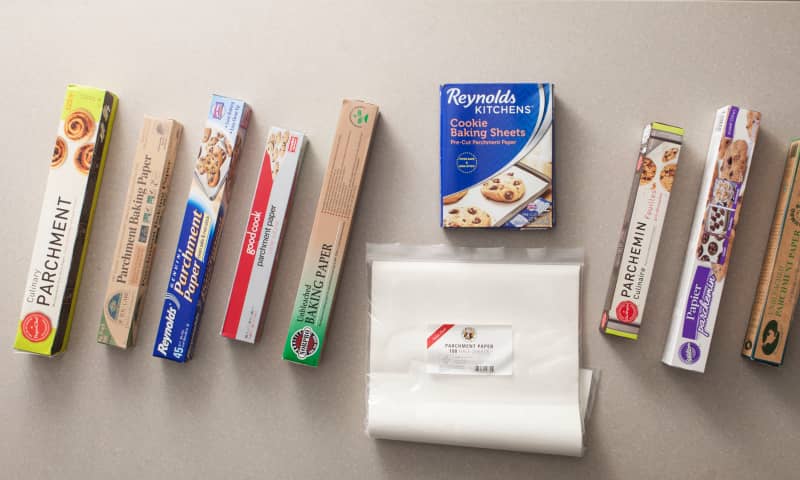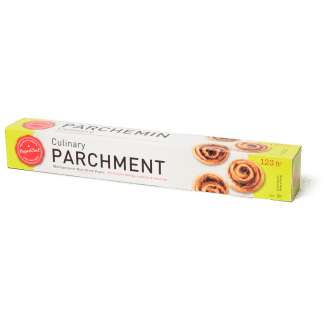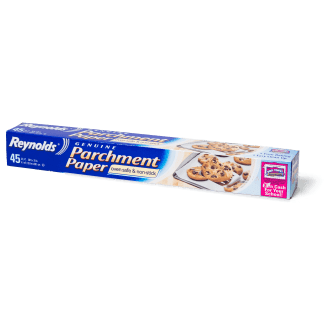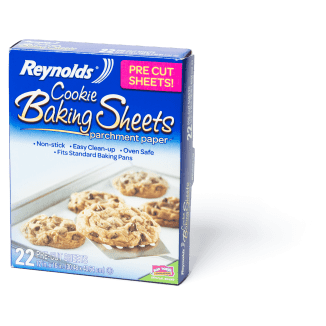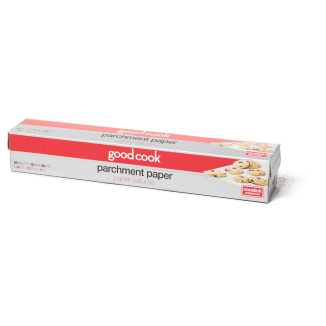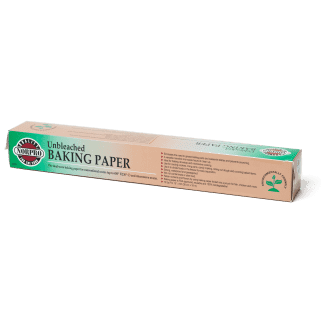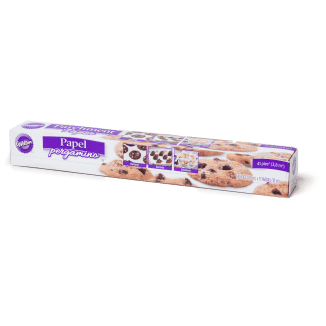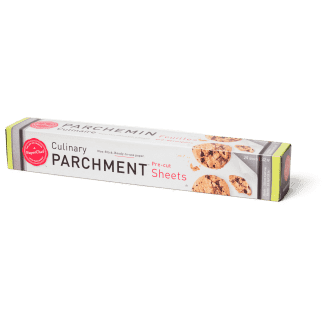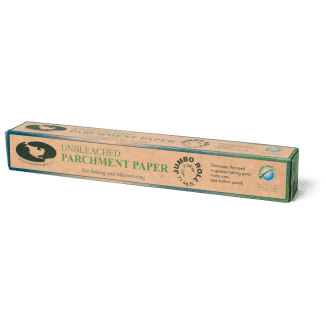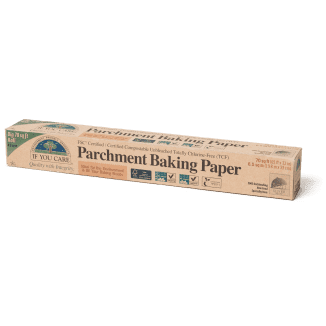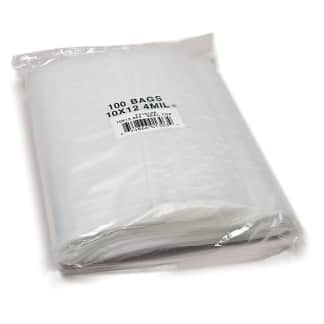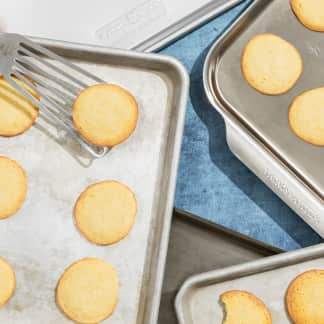Whenever a piece of restaurant equipment becomes available to home cooks, we take notice. Replacing flimsy jelly roll pans with sturdy rimmed baking sheets changed the way we cook. Using bench scrapers and Y-shaped vegetable peelers made our prep work more efficient. More expensive and esoteric tools, such as high-powered blenders, sous vide machines, and carbon-steel skillets, have also transitioned from restaurant to home kitchens.
Recently, a low-frills restaurant product appeared on supermarket shelves: parchment paper sheets, a precut version of the rolls that we have long used to line baking sheets. Since the sheets are cut to the approximate dimensions of a standard rimmed baking sheet, no trimming is necessary, which saves time and waste. And unlike rolled parchment, which needs to be wrestled out of its box and smoothed, some parchment sheets store completely flat.
Given that not every restaurant product successfully transitions to home kitchens, we were curious but skeptical. How would these new commercially inspired products compare with traditional parchment paper rolls? To find out, we purchased 10 parchment paper products: seven rolls and three packages of precut sheets.
Parchment Performance
Parchment paper's primary function is to keep food from sticking to baking sheets (although it's handy for lots of other kitchen tasks, too). Happily, all the papers we tested produced cakes, cookies, and pizzas that were evenly baked and that released cleanly. They also performed well outside the oven. None tore under heavy pizzas or pie weights or caught fire in a 500-degree oven. (Even if products list lower maximum temperatures, we've learned from manufacturers that they're still safe to use in a hot oven.) When we sandwiched and rolled out disks of cookie dough between two sheets of each paper, none of them stuck, tore, or crumpled. So we turned our attention to how easy they were to use. In these evaluations, scores were anything but even.

For Parchment Rolls, Two Things Mattered
The user-friendliness of the rolls boiled down to two factors: size and cutting mechanism. Most were too wide. The cooking surface of a standard rimmed baking sheet measures 16½ by 11½ inches, yet most rolls were between 13 and 15 inches wide. Positioning them in a baking sheet widthwise left a wide swath of the baking sheet exposed; positioning them lengthwise forced us to trim 1 to 3 inches of paper. On the widest rolls, about 15 inches across, that trimming resulted in 20 percent waste. Only one roll measured 12 inches across, almost the same width as our baking sheets.

We also preferred rolls that were easy to tear into sheets with straight, clean edges. Success was due to both the cutting mechanism and the packaging. Some products have simple designs: The user tears the paper against the front edge of the container. Boxes that weren't sturdy were a pain to use: The cutting edge folded over and became ineffective, meaning that the parchment crumpled in the corners and tore jaggedly or jumped out of the widened opening and unspooled on the floor. Our favorite parchment roll products relied on tension: The front edge of the lid tucks inside the box (like a takeout pizza box), which holds the roll in place and provides a firm, blunt edge that facilitates crisp, clean tears.
Were Precut Parchment Sheets Better?
All the precut sheets, which measured about 16 by 12 inches, fit in a standard rimmed baking sheet without trimming. They were big enough to use when rolling out disks of cookie dough, lifting pie weights, and maneuvering pizzas around the kitchen. They were too short by a few inches to use for rolling jelly roll cakes into coils, but using two overlapping sheets was an easy work-around.
And just as with the parchment rolls, packaging influenced which products we preferred. Two had compact boxes. In one of these, the sheets were rolled together in a way that allowed us to pull out a single sheet without unspooling the whole roll. Though it was easy to separate the sheets, it was a struggle to flatten them. Even when we positioned the curled edges down, the sheets often jumped up and sprung into a tight scroll. The other product was also frustrating; it was folded in quarters and packaged in a roughly 8 by 6-inch box. The sheets were so tightly creased that even the weight of cake batter or pizza dough wasn't enough to flatten out the peaks and valleys. As a result, baked goods were marked with deep lines and Xs.

Our favorite parchment was stored flat in a large zipper-lock bag, so sheets never got wrinkled or creased. Sized just right and perfectly smooth, they practically floated into baking sheets.
The Most Practical Paper
After weeks of tearing, trimming, and flattening paper, we had a newfound appreciation for products that didn't require so much fuss. King Arthur Flour Parchment Paper 100 Half-Sheets (about $20 for 100 sheets, plus shipping) is the only one that combines precut sheets—which eliminate the need to trim and tear—with packaging that allows them to be stored flat. This parchment slid neatly into a rimmed baking sheet and fit it well. Our runaway favorite is priced similarly to other products in our lineup and is well worth the cost. It's the latest commercial-inspired home product that will have you wondering how you ever got by without it.

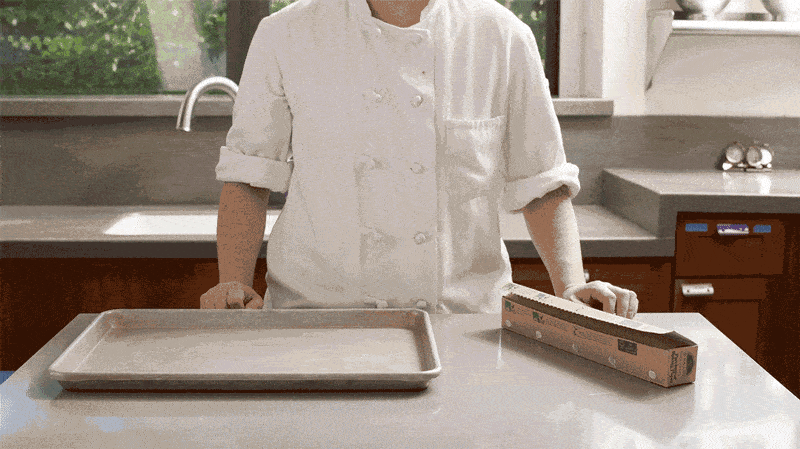
The Tests:
- Bake 2 batches of cookies (Thin Crisp Gingerbread Cookies and Glazed Lemon Cookies), checking for release and uniform browning
- Bake jelly roll cake, checking for easy release and uniform browning
- Bake pizza in a 500-degree oven and inspect paper for scorching, brittleness, and tears
- Roll disks of cookie dough between sheets of parchment, checking for sticking, wrinkling, and lasting marks
- Roll baked jelly roll cake to form tight coil
- Use paper to line tart shells, filling them with heavy pie weights for blind baking, lifting out paper, and carrying the hot pie weights to test durability
- Evaluate strength and durability of product packaging
- Tear off roughly 12 by 16-inch sheets and note how easy it is to get appropriate size and straight, neat edge (rolls only)
- Calculate approximate number of 12 by 16-inch sheets and convert to approximate price per sheet (rolls only)
- Empty contents of packaging sheet by sheet to see if cutting edge dulls and if paper at center of roll is more prone to curling
- Conduct at-home user testing by asking participants to bake chocolate chip cookies and store the parchment in their kitchen cabinets and drawers
How We Rated:
- Performance: We baked two kinds of cookies, jelly roll cake, and pizza with each paper, checking to see how easily foods released and if they had even, consistent browning.
- Size: We used each parchment paper to line standard-size rimmed baking sheets, whose cooking surface measures 16½ by 11½ inches. Papers rated best if they fit in the baking sheets straight from the package or with minimal trimming.
- Handling: Sheets of perfectly flat parchment paper were easy to use and ensured that foods baked evenly with smooth surfaces. We docked points from papers that curled, were creased, or were generally difficult to lay flat. Products that negatively affected the appearance of our baked goods lost points.
- Packaging: We evaluated the design and construction of the packaging. For sheets, the best packaging allowed the paper to be stored flat. For rolls, good packaging had firm, rigid edges or sharp teeth that facilitated clean, neat tears. Products lost points if their packaging fell apart or became misshapen during testing.
- Food releases evenly
- Food browns evenly from edge to edge
- Paper is strong enough to support pie weights and heavy food
- Paper fits in standard-size rimmed baking sheet with minimal trimming
- Paper is flat or requires little effort to smooth out
- Packaging dispenses paper without crumpling or creasing it
- Packaging is durable
